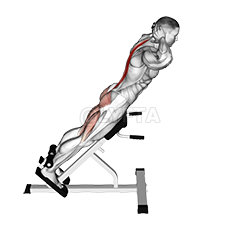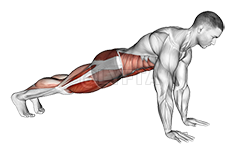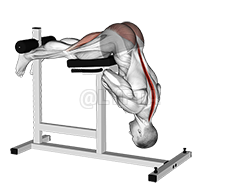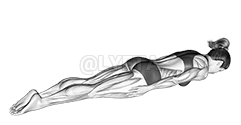
Hyperextension
Exercise Profile
Related Exercises:
Introduction to the Hyperextension
Hyperextension is a beneficial exercise that primarily strengthens the lower back, but also engages the glutes and hamstrings. It is suitable for anyone, from fitness beginners to seasoned athletes, looking to improve their core strength, posture, and overall back health. Individuals might want to perform this exercise to alleviate back pain, enhance athletic performance, or prevent future back-related issues.
Performing the: A Step-by-Step Tutorial Hyperextension
- Keep your body straight and your hands either crossed on your chest or behind your head, this is your starting position.
- Begin the exercise by bending at the waist while keeping your back straight, continue to lower your torso until it's almost perpendicular to your legs.
- Slowly raise your torso back to the initial position without arching your back, using your lower back muscles to lift your body.
- Repeat the movement for the desired number of repetitions, making sure to maintain a slow and controlled motion throughout.
Tips for Performing Hyperextension
- Controlled Movements: Another mistake is rushing the exercise and not controlling the movements. It's important to perform the exercise slowly and deliberately. This includes both the upward and downward phases of the exercise. By controlling your movements, you can ensure that your muscles are being properly worked and that you're not relying on momentum to complete the exercise.
- Engage Your Core: Many people forget to engage their core while performing Hyperextensions. By engaging your core, you can help to protect your lower back and also increase the effectiveness of the exercise.
- Don't Overextend: Overextending at the top of the movement is a common mistake that can
Hyperextension FAQs
Can beginners do the Hyperextension?
Yes, beginners can do the hyperextension exercise, but it's important to start slowly and with proper form to avoid injury. It's recommended to have a trainer or experienced individual demonstrate the exercise first. Additionally, beginners should start with body weight only and gradually add resistance as they become more comfortable and stronger. As with any exercise, if there's any pain, they should stop immediately and consult a healthcare professional.
What are common variations of the Hyperextension?
- The 45-Degree Hyperextension: In this variation, the individual uses a 45-degree hyperextension bench, which allows a larger range of motion and targets the lower back and hamstrings.
- The Standing Hyperextension: This variation is performed while standing, using resistance bands attached to a low anchor point to provide the resistance.
- The Reverse Hyperextension: This variation is performed on a reverse hyperextension machine, primarily targeting the hamstrings, glutes, and lower back muscles.
- The Single-Leg Hyperextension: This variation is performed by lifting one leg off the ground during the exercise, which increases the challenge and helps to improve balance and stability.
What are good complementing exercises for the Hyperextension?
- Planks are a good complement to Hyperextensions as they strengthen the core muscles, which are crucial for maintaining proper form and preventing injury during Hyperextensions.
- Bird Dog exercises also complement Hyperextensions by engaging both the lower back and core muscles, improving balance and stability, which are important for performing Hyperextensions effectively.
Related keywords for Hyperextension
- Bodyweight Hyperextension exercise
- Waist-targeting workouts
- Hyperextension for waist shaping
- Body weight exercises for waist
- Hyperextension waist workout
- Waist strengthening with Hyperextension
- Hyperextension waist exercises
- Bodyweight workouts for waist
- Waist-focused Hyperextension exercise
- Waist slimming Hyperextension workouts









